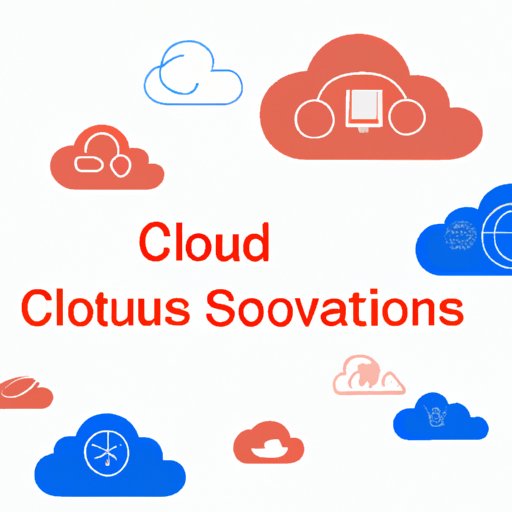Introduction
Cloud technologies are quickly becoming the standard for businesses of all sizes. From startups to enterprise organizations, cloud solutions offer an array of advantages that can help companies stay competitive, increase productivity, and reduce costs. But before you make the switch, it’s important to understand both the benefits and challenges of adopting cloud solutions.
What is Cloud Computing?
Cloud computing is a type of computing that relies on shared computing resources rather than having dedicated hardware for each user. It allows users to access applications, services, and data from anywhere in the world, with no need for installation or setup. Cloud platforms, applications, and services are hosted by cloud providers such as Amazon Web Services (AWS), Microsoft Azure, Google Cloud Platform, and IBM Cloud.
Popular cloud technologies include Infrastructure as a Service (IaaS), Platform as a Service (PaaS), and Software as a Service (SaaS). IaaS provides users with access to virtualized computing resources such as storage, networking, and servers. PaaS offers users a platform for developing, testing, and deploying applications. SaaS provides users with access to software applications without needing to install them on their own systems.
Pros and Cons of Cloud Computing vs On-Premise Solutions
When considering cloud solutions, it’s important to weigh the pros and cons of cloud computing versus on-premise solutions. Here are some of the advantages and disadvantages of each:
Advantages of Cloud Computing
- Flexible, scalable, and cost-effective
- Reduced need for IT infrastructure and personnel
- Automatic updates and patches
- Increased collaboration and productivity
- Improved data security
Disadvantages of Cloud Computing
- Potential latency issues
- Vendor lock-in
- Reliance on internet connection
- Possible compliance issues
- Unknown service levels
Advantages of On-Premise Solutions
- More control over data and system configurations
- Increased customization options
- No reliance on internet connection
- Familiarity with existing systems
Disadvantages of On-Premise Solutions
- Higher upfront costs
- Increased maintenance and support costs
- Less flexibility when scaling up or down
- Difficulty staying up-to-date
- Increased risk of data loss or security breaches

6 Reasons Why Cloud Technologies Are Becoming More Popular
Cloud technologies are becoming increasingly popular due to the following advantages they offer:
Increased Productivity
With cloud solutions, users have access to the latest software and applications, which can significantly improve productivity. With on-premise solutions, users must manually update software and applications, which can take time and effort.
Improved Security
Cloud providers use advanced security measures to protect data and systems from cyberattacks. This includes encryption, multi-factor authentication, and other security protocols. Additionally, cloud providers typically have more resources to invest in security than most organizations.
Lower Costs
Cloud solutions are generally more cost-effective than on-premise solutions. This is because cloud providers typically charge a monthly fee instead of an upfront cost. Additionally, cloud providers often offer discounts for long-term commitments.
Enhanced Collaboration
With cloud solutions, teams can easily collaborate on projects from anywhere in the world. This makes it easier to share files and communicate in real-time, allowing teams to work more efficiently.
Increased Flexibility
Cloud solutions are highly flexible, making it easy to scale up or down depending on your needs. This makes it easier to add new users or modify existing configurations without needing to purchase additional hardware.
Easier Maintenance
Cloud providers handle maintenance, upgrades, and patching, so users don’t have to worry about managing these tasks. This frees up time and resources that can be used for other projects.
How to Choose the Right Cloud Technology for Your Business
Now that you know the advantages and disadvantages of cloud solutions, it’s time to decide which one is right for your business. Here are some tips to help you choose the best cloud technology:
Consider Your Current Needs
Start by assessing your current needs. What type of applications and services do you need to run your business? How many users will need access? Answering these questions can help you determine which type of cloud solution is best for you.
Evaluate Your Future Requirements
It’s also important to consider your future requirements. Do you plan to add new users or features in the near future? If so, you may want to choose a cloud solution that is easily scalable.
Understand Your Budget
Your budget is another important factor to consider. Make sure you understand the total cost of ownership, including any fees or additional charges associated with the cloud solution you choose.
Assess Your Security Needs
Security is an essential consideration when choosing a cloud provider. Make sure the provider has the necessary security protocols in place to protect your data and systems.
Research Potential Providers
Finally, research potential cloud providers. Read reviews, compare pricing plans, and speak with other customers to get a better understanding of the provider’s services and customer service.
Conclusion
Cloud technologies offer a range of advantages, from increased productivity and improved security to lower costs and enhanced collaboration. While there are some drawbacks to adopting cloud solutions, these can be minimized with careful planning and research. To find the right cloud technology for your business, consider your current and future needs, understand your budget, assess your security needs, and research potential providers.
Making the switch to cloud technologies can be daunting, but the rewards are worth the effort. With the right cloud solution, you can reap the benefits of increased productivity, improved security, and lower costs.
(Note: Is this article not meeting your expectations? Do you have knowledge or insights to share? Unlock new opportunities and expand your reach by joining our authors team. Click Registration to join us and share your expertise with our readers.)
